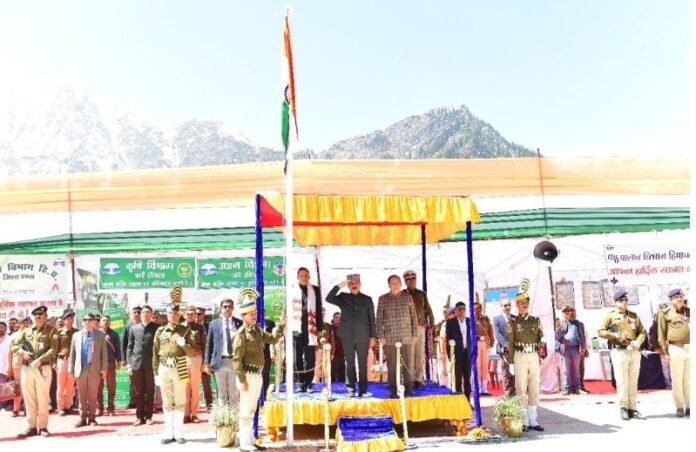For the first time in its history, Himachal Pradesh marked its State-Level Himachal Day celebrations in the remote and rugged terrain of Killar in Pangi Valley, Chamba district—an event that not only symbolized the state’s deepening commitment to inclusive growth but also brought with it a string of transformational announcements. As the 78th Himachal Day unfolded against the stunning Himalayan backdrop, a large gathering of locals witnessed the occasion with pride, standing shoulder to shoulder in celebration of a moment that placed this secluded valley at the heart of the state’s development discourse.
Chief Minister Sukhvinder Singh Sukhu, who presided over the ceremony, paid tribute to the architects of Himachal Pradesh’s statehood—particularly the first Chief Minister, Dr. Y.S. Parmar, and former Prime Minister Indira Gandhi, whose visit to Pangi in 1984 had, as he noted, catalyzed development in this neglected part of the state. His arrival in Killar brought more than just ceremonial gestures; it brought vision and policy announcements aimed at integrating Pangi into the mainstream narrative of growth.
Unfurling the national flag and taking the ceremonial salute, the Chief Minister observed a vibrant parade led by contingents from the Indian Reserve Battalion, Home Guards, and NCC cadets, many of whom were local youth—a reflection of pride and participation. But it was in his address that the tone of transformation became clear.
Among the landmark declarations was the designation of Pangi as the first “Natural Farming Sub-Division” in Himachal Pradesh. To strengthen this eco-sustainable agricultural shift, he committed a revolving fund of ₹5 crore and introduced a minimum support price (MSP) of ₹60 per kg for naturally grown barley. In a valley where traditional farming is intrinsic to the way of life, this move not only acknowledges indigenous knowledge systems but also encourages organic production models that benefit both the land and the people.
Power infrastructure saw a significant push with the announcement of ₹45.50 crore for a 33 KV power line from Thirot to Killar and an additional ₹5 crore for an 11 KV line from Tindi to Shaur—projects that promise consistent electricity and stability in a region often challenged by weather and terrain. These are part of a broader ₹62 crore energy plan aimed at upgrading Pangi’s grid.
Equally promising was the boost to transportation. The CM announced 20 new bus permits specifically for the valley and a 40% subsidy on the purchase of new buses. For local entrepreneurs and self-help groups, this presents an opportunity to improve connectivity and livelihoods. Adding to this, homestays in the region will now benefit from a 50% waiver on registration fees, a step likely to encourage rural tourism in the remote but culturally rich valley.
The development vision also extends to health and education. The Civil Hospital in Killar will be developed into a model health institution, while a Rajiv Gandhi Day Boarding School will soon serve the region’s children. For better road access, the CM allocated ₹1.5 crore for link road improvements and reaffirmed that the long-pending Udaipur-Killar road project is a top priority, with tender processes already in motion.
What makes this celebration stand out is that it wasn’t merely a symbolic gesture but a platform for announcing structural and financial investments aimed at equity. Sukhu reiterated that Himachal’s tribal areas will be key stakeholders in the state’s green energy future. He invited residents to install solar energy plants, promising a 5% interest subsidy on solar setups from 250 KW to 1 MW capacity.
The CM also addressed wider governance reforms. Under the newly restructured education model, the Directorate of School Education will oversee schooling up to Class 12, while higher education will come under a separate directorate. In healthcare, Himachal will invest ₹1570 crore in state-of-the-art medical equipment, including PET scans and MRI machines for key hospitals in Shimla and Tanda.
He further announced a one-time loan settlement policy for farmers under the Agriculture Interest Subvention Scheme, whereby loans up to ₹3 lakh will receive a 50% interest subsidy from the state government. This policy could be a game-changer for small and marginal farmers on the brink of losing their land.
The anti-drug drive also found mention, with a commitment to strengthen the Anti-Narcotics Task Force and create a special unit to tackle the growing threat. The CM’s remarks on the Congress government’s accountability to tribal areas and focus on reviving the rural economy sent a clear message: development is not reserved for the accessible; it must reach the farthest corners.
Celebrating environmental conservation with economic empowerment, Sukhu highlighted the Rajiv Gandhi Van Samvardhan Yojana—₹100 crore earmarked to help women and youth earn livelihoods through forest protection. Groups formed under this scheme will receive ₹6.40 lakh over five years.
The pride in the achievements was palpable. Himachal Pradesh recently earned accolades from the India Today Group for its tourism sector: Bir Billing was awarded “Best Adventure Destination” and Dharamshala “Best Mountain Destination.” Additionally, Panchayat-level water sustainability initiatives in Hamirpur earned national recognition.
As State-Level Himachal Day wrapped up in Killar, what lingered was not just a sense of festivity, but a renewed trust that the government sees and hears its most remote citizens. For Pangi, this was more than a celebration—it was a new beginning.
#HimachalDay #KillarCelebration #CMAnnouncements #NaturalFarming #GreenEnergyState #TribalDevelopment




